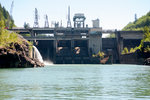
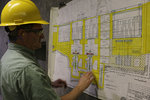

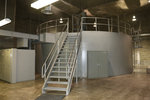
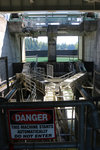
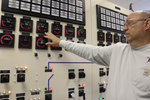
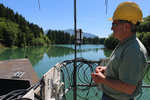
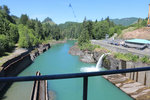
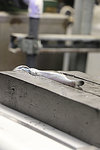
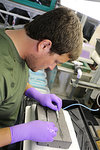
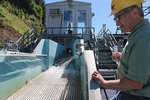
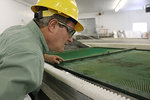
COWLITZ RIVER — There’s a fine balance to the work being done at the Cowlitz Falls Dam.
The facility, owned by the Lewis County Public Utilities District, generates enough electricity for 30 percent of the county’s PUD customers while also striving to help salmon recovery efforts through a number of partnerships.
The project, situated about 13 miles downstream from Randle and a few miles from Riffe Lake, is the uppermost of four dams on the Cowlitz River.
The 140-foot high concrete gravity dam functions as a “run-of-the-river” operation, generating electricity solely with the water that comes through the facility.
As the water moves through the energy-generating units, so do fish, spurring a plethora of efforts to help ensure low mortality rates.
“There is a balance, and we want to be able to have power and fish,” John Serl, a fish biologist with the Washington Department of Fish and Wildlife, said. “We want to get all the benefits we can from the river.”
Power Production
The Cowlitz Falls Dam is a 70-megawatt hydroelectric facility that spans approximately 700 feet across the picturesque Cowlitz River.
Two units, each equipped with a generator and turbine, help produce up to 35 megawatts each when at maximum capacity as water flows reach approximately 5,000 cubic feet per second.
That equates to about 2.24 million gallons a second.
Because the dam generates electricity based on the volume of water entering the units, it solely depends on the river for energy production.
This year, record low water flows have the facility generating at 13 megawatts, resulting in a 33 percent decrease in power production for the month of May.
With only 1,900 cubic feet per second funneling into the facility, one turbine remains offline while the other processes the incoming water.
Each turbine, along with the shaft and rotor, weigh approximately 210 tons and are capable of rotating 150 times per minute.
The turbines cannot operate below 12 megawatts without getting damaged, so the facility is almost at its minimum operating range as stream flows are 31 percent of normal.
Joe First, project manager at Cowlitz Falls Dam, said he expects June to also see a deficit, although it may not be as low as 31 percent.
Don Powell, a journeyman operator at the facility, said in his 21 years of experience at the dam, he has never seen water flows this low, adding the numbers they are seeing now are typical of late August when river flow is at its lowest.
First predicted that by the end of summer, water flow will be down to 800 CFS, a number typically seen during that time.
The low production levels of the facility will not impact Lewis County PUD customers because of a long-term contract with Bonneville Power Administration.
Under the contract, which began in 1994 and will continue through 2032, BPA pays all the costs associated for the operation and maintenance of the dam, which is owned by the PUD.
In return, BPA purchases 100 percent of the power generated at the facility. Lewis County PUD then buys its power back from BPA, helping to provide county residents and businesses with service.
When water levels reach below the 12 megawatt minimum to produce power, the facility uses a 2-foot operating range to essentially “pool up” the water. The generator is turned off during this process and switched back on once the water is high enough to continue operations.
“That part is a normal cycle we do every year,” First explained. “But we will be doing it earlier than we have in an average year.”
The energy created at the dam is then directed to a substation located 6 miles away in Glenoma. From there, the power travels through a transmission line to Mossyrock, while a separate line brings energy to the Packwood area.
From Packwood, it travels down to Chehalis, creating a “backbone” of power for the county, First said.
Salmon Recovery Efforts
Situated just downriver from the dam is the Cowlitz Falls Fish Facility, an anadromous fish collection site. The building, currently owned by Tacoma Power, permits the reintroduction of salmon and steelhead in the upper Cowlitz River Basin.
Fish are funneled into four flumes located at the top of two of the dam’s spillways. The flumes have a 20 cubic feet per second flow, attracting the fish into the slide-like structures, which later conjoin to create 80 cubic feet per second of water flow.
The fish are sorted by size through a grate system, and the juvenile fish are filtered into the fish facility where they are counted and tagged.
Two groups work side by side to count and tag fish as part of the dam’s biological opinion put in place by the Federal Energy Regulatory Commission. The stipulations and requirements of the biological opinion mandated by the federal government require Lewis County PUD to perform studies and take action to help with salmon restoration, First said.
Officials with the U.S. Geological Survey are tasked with implanting radio tags into salmon smolt. Smolts are salmon in the process of heading out to sea, and typically range between 3 and 5 inches in length.
Brian Ekstrom, a biological science technician with USGS, said his crew was looking at the survival of juvenile fish through the passage routes of the dam. Antennas located at the entrance of the dam help track the radio-chipped fish.
Due to the low water levels, only one passage route through the dam exists, which is through the turbines. Next year, the hope is to expand the study to look at survival of fish that pass through one of the three spillways at the dam, if water levels allow.
The other group working at the fish facility is the Washington Department of Fish and Wildlife.
These officials, hired by Tacoma Power, use a coded wire tag that is inserted into the nose carpal of the smolts. When the fish return as adults, the magnetized wire strip helps determine what river the fish came from. Those with a strip originated in the Cowlitz or Cispus rivers, while those without most likely originated in the Tilton River, which feeds into Mayfield Lake and essentially joins the Cowlitz.
Although water flows have significantly decreased power production for the Cowlitz Falls Dam, it has had positive effects on the amount of fish coming through the facility.
Fish counters are seeing a near-record amount of smolts.
For the past two weeks, the average amount has been between 6,000 and 8,000 a day.
In all, Serl said they have seen approximately 175,000 fish and will continue counting until the end of August. Last year, just over 93,000 smolts came through the facility. The numbers have already surpassed the average of 155,000 fish typically seen during the season.
Mike Kohn, the Cowlitz Falls Project biologist, said the numbers are high this year in part due to the drought. Typically, when the water flow is higher, the collection numbers decrease because fish pass through the turbine units or through the spillways.
The low water levels have allowed fish collection in the 90 percent range, he said.
Once the fish are marked or tagged, a trap and haul program is used. The smolt are put into trucks and are transported downstream below the barrier dam in Salkum, where they are released before continuing their journey to the ocean. The adult fish return to the area and are then collected again in trucks and transported above the Cowlitz Falls Dam to be released.
Tacoma Power North Shore
Fish Collector
Much of the salmon recovery project is shouldered by Tacoma Power because the Mossyrock and Mayfield dams the utility company owns blocked upstream and downstream passages for fish.
The problems the dams caused were in place prior to the construction of the Cowlitz Falls Dam. Although the PUD facility has obligations for fish restoration, First said the bulk of the restoration efforts were designated to Tacoma Power by the federal government.
To help increase fish survival rates to 95 percent, as mandated by the Federal Energy Regulatory Commission, Tacoma Power is currently in the process of constructing a $35.5 million fish collector at the Cowlitz Falls Dam.
Kirk Kessler, professional engineer for Tacoma Power, said a license from the Federal Energy Regulatory Commission in 2002 assigned the company with the responsibility for downstream fish passages because of its larger dams located downstream.
The best place to build the facility was on the uppermost dam, or the Cowlitz Falls Dam, he said.
Lewis County PUD is working together with Tacoma Power on the project, although Tacoma Power is funding it.
Work began last week and the hope is the collector will be operational by April 2017.
The purpose will be to capture downstream migrating salmon and smolt through an entrance that will be bored through the gravity section of the dam.
“We’re basically saw cutting the hole through that dam to connect the reservoir with the fish collector,” Kessler said.
Matt Bleich, the fish biologist in charge of the collector, said the project should increase fish collection at the Cowlitz Falls Fish Facility.
A number of challenges were addressed during the initial process, he said.
Officials had to determine how to get out-migrating juvenile fish to discover the collector, enter the artificial system and retain them.
“A lot of energy was put into the design and will be put into the evaluation into effectiveness based on those kinds of metrics,” he said.
The Cowlitz Falls Fish Facility will also undergo a redesign to accommodate for the growth of the fish collection program.
“This is one of the key cogs within the overall system we are working in the Cowlitz Basin,” Bleich said of the collector.